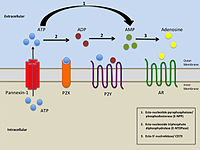| Part of a series on |
| Purinergic signalling |
|---|
 |
| Concepts |
| Membrane transporters |
Purinergic signalling (or signaling: see American and British English differences) is a form of extracellular signalling mediated by purine nucleotides and nucleosides such as adenosine and ATP. It involves the activation of purinergic receptors in the cell and/or in nearby cells, thereby regulating cellular functions.[1]
It was proposed after Adenosine triphosphate (ATP) was identified in 1970 as the transmitter responsible for non-adrenergic, noncholinergic neurotransmission. Nowadays is it known that ATP acts a cotransmitter in most, if not all, nerves in the central and peripheral nervous system.[2]
Receptors for adenosine (called P1) and for ATP and ADP (called P2) were distinguished in 1978. Later, the P2 receptors were subdivided into P2X and P2Y families based on their different mechanisms. In the early 1990s, when the receptors to purines and pyrimidines were cloned and characterized, numerous subtypes of P1 and P2 receptors were discovered.[3]
The purinergic signalling complex of a cell is sometimes referred to as the “purinome”.[4]
- ^ Cite error: The named reference
annualreviewwas invoked but never defined (see the help page). - ^ Burnstock, Geoffrey (March 2012). "Purinergic signalling: Its unpopular beginning, its acceptance and its exciting future". BioEssays. 34 (3): 218–225. doi:10.1002/bies.201100130. ISSN 0265-9247.
- ^ Burnstock, Geoffrey (January 2018). "Purine and purinergic receptors". Brain and Neuroscience Advances. 2: 239821281881749. doi:10.1177/2398212818817494. ISSN 2398-2128. PMC 7058212. PMID 32166165.
- ^ Volonté, Cinzia; D’Ambrosi, Nadia (2009). "Membrane compartments and purinergic signalling: the purinome, a complex interplay among ligands, degrading enzymes, receptors and transporters: The purinome". FEBS Journal. 276 (2): 318–329. doi:10.1111/j.1742-4658.2008.06793.x. PMID 19076212.